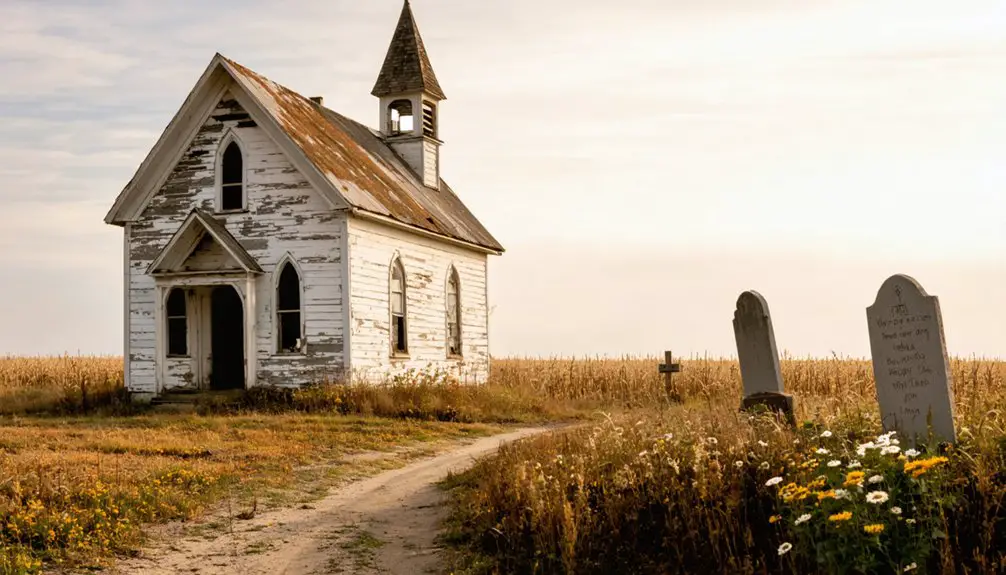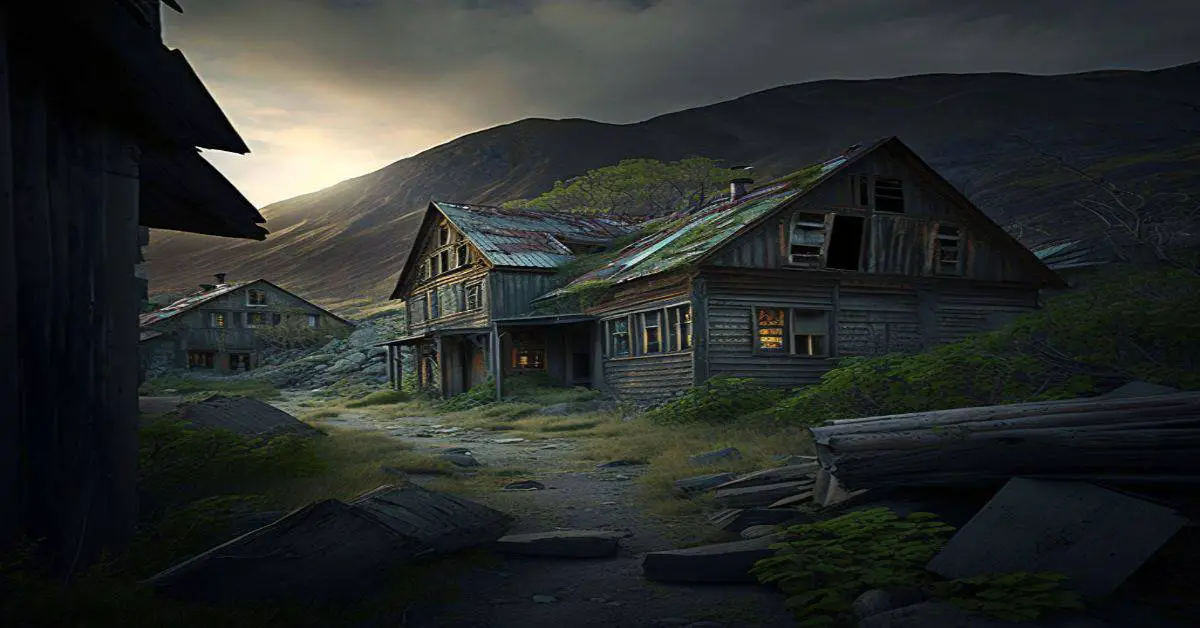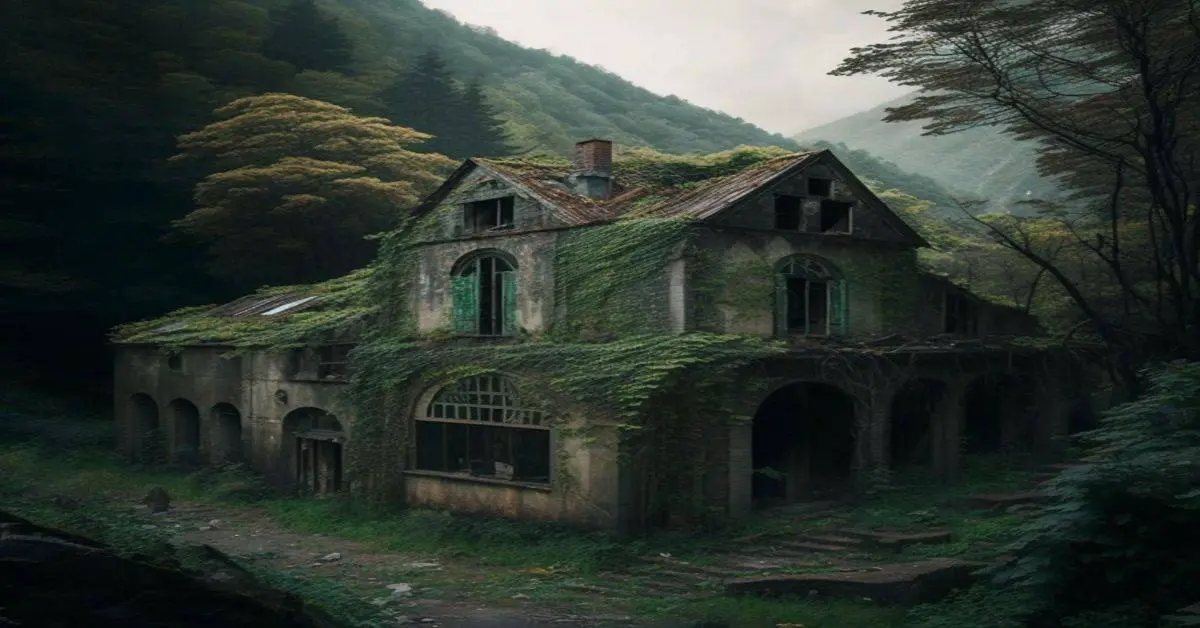You’ll find the ghost town of Leer deep within Michigan’s Huron National Forest, where Norwegian immigrants established a lumber settlement in the late 1860s. The town thrived during Michigan’s peak logging years but faced devastating setbacks, including a deadly diphtheria outbreak in the 1870s that claimed hundreds of lives. Today, you can explore its historic cemetery containing roughly 90 graves, where visitors leave coins and toys as offerings. The site’s haunting legends and tragic past hold deeper secrets within its forested remains.
Key Takeaways
- Leer emerged from Norwegian immigrants in the 1860s and thrived during Michigan’s lumber boom from 1869 to 1899.
- The town suffered a devastating diphtheria outbreak in the 1870s, which killed hundreds of residents, especially children.
- A historic cemetery containing approximately 90 graves remains, where visitors leave offerings like coins and toys.
- Local folklore includes stories of a witch’s curse, mysterious murders, and supernatural encounters including glowing orbs.
- The ghost town’s ruins are located within Huron National Forest and require GPS navigation to access.
The Rise of a Northern Michigan Settlement
While many Michigan settlements emerged from the lumber industry, Leer’s story began with Norwegian immigrants seeking a fresh start in the late 1860s.
Unlike many Michigan lumber towns, Leer emerged from Norwegian pioneers searching for a new beginning during America’s late 1860s expansion.
You’ll find its roots in the pioneering spirit of Bernhard Enger, Otter Olsen, and Andreas Christopherson, who first explored the Sunken Lake area.
The settlement patterns reveal how these determined immigrants purchased land from George Fletcher and the Richardson Lumber Company, establishing their mark in northern Long Rapids Township.
Their cultural heritage stayed strong as more Norwegian families – the Andersons, Alfsens, Olsons, and others – joined the community.
They didn’t just build farms; they created a thriving Norwegian enclave that reflected their homeland, even naming their new community after Lier, Norway.
Early businesses, including Carl Alfsen’s store, quickly followed, transforming wilderness into a vibrant settlement. The first Leer School was built in 1908, marking a significant milestone in the community’s development.
Like many settlements in the Upper Peninsula, the area was rich with dense forests that contributed to Michigan’s booming lumber industry.
Life in Leer’s Lumber Era
Once Leer’s Norwegian settlers established their foothold, the lumber industry quickly transformed the wilderness into a bustling hub of activity.
You’d find experienced loggers from New England states working alongside local crews, wielding axes and crosscut saws to fell massive white pines that had stood for over two centuries. Their logging practices focused on clear-cutting, moving timber swiftly via rivers and later by rail. The early operations primarily targeted white, jack, and Norway pines that dominated the landscape.
The community dynamics centered around seasonal rhythms, with winter being prime time for hauling logs across frozen ground. The town thrived during the industry’s peak when Michigan was leading lumber producer from 1869 to 1899.
You could witness the liveliness of logging camps, complete with cookhouses and social spaces, while the town itself buzzed with blacksmiths, general stores, and saloons.
These camps formed temporary but thriving communities that supported the demanding work of Michigan’s booming lumber trade.
The Devastating Diphtheria Outbreak
During the late 1870s, a devastating diphtheria outbreak struck Michigan’s lumber communities, including Leer, with unprecedented force. You’d have witnessed the disease’s horrific impact as it claimed hundreds of lives, particularly among children under five. The “strangling angel” earned its name from the thick, gray membrane that formed in victims’ throats, often leading to suffocation within days. No cure was available as desperate families watched helplessly while the disease claimed their loved ones.
Local health challenges included poor reporting and limited medical resources in remote lumber camps. You wouldn’t have found much coverage in newspapers like the Mining Journal, which avoided reporting on the epidemic. The communities along rail and logging routes experienced higher mortality rates as the disease spread through these vital transportation networks.
The disease spread rapidly through close contact in worker communities, while contaminated milk and dairy products likely accelerated transmission. By 1878, diphtheria had become Michigan’s leading child killer, with 887 deaths that year alone.
Local Legends and Supernatural Tales
Among Michigan’s most haunted locations, Pere Cheney’s ghostly legacy stems from a dark tale of an accused witch who allegedly cursed the town in 1874.
After townsfolk banished her to the woods, where her child died of sickness, local folklore claims her curse brought devastation through fires and disease outbreaks.
Visitors and family members have placed rocks as markers on many graves to help preserve the site from vandalism.
The cemetery, with its 90 graves, remains the epicenter of supernatural encounters.
You’ll find reports of glowing orbs, mysterious handprints on cars, and the eerie sounds of children’s laughter.
Beyond the graveyard, visitors often sense an ominous presence among the town’s ruins.
While some attribute the haunting to an alleged Native American burial ground, these claims lack historical evidence.
The town’s complete abandonment by 1918 marked the final chapter of Pere Cheney’s tragic history.
Yet, these unexplained phenomena continue drawing paranormal enthusiasts to explore Pere Cheney’s ghostly remains.
What Remains: The Historic Cemetery
The historic cemetery in Leer stands as the most tangible remnant of this vanished community. When you visit today, you’ll find roughly 90 graves scattered across the isolated grounds, where coins, toys, and rocks left as cemetery offerings mark the silent headstones. Similar to the infamous Blood Cemetery in Laingsburg, local folklore and paranormal enthusiasts are drawn to the site’s dark history.
The site’s eerie atmosphere is enhanced by sparse vegetation and weathered markers, many belonging to children under eight years old. Located across train tracks from the former townsite, the cemetery offers a haunting glimpse into Leer’s tragic past.
Scattered headstones of young children peek through thin grass, their weather-worn faces telling silent stories of lives cut tragically short.
- Wooden crosses and stone markers show varying states of preservation
- Family plots reveal connections to Leer’s founding settlers
- Visitor experiences often include reports of being watched
- Children’s graves frequently display stuffed animals and small toys
- Nearly every visible headstone bears coins or rocks from recent visitors
Local authorities maintain the grounds, preserving this essential piece of Michigan’s ghost town heritage and the final resting place of the community’s earliest residents.
Notable Characters and Their Stories
You’ll find some of Leer’s most intriguing stories center on three mysterious deaths from its sawmill days: a local woman accused of witchcraft who died under questionable circumstances, a mining supervisor whose murder remained unsolved, and a pastor who collapsed during his final sermon.
While Herman Bane’s determined leadership helped sustain the town through difficult times, he couldn’t prevent these dark chapters from becoming part of Leer’s permanent lore.
The Finnish workers who settled permanently in the area passed down these tales through generations, preserving the memory of Leer’s most notorious moments.
Accused Witch’s Dark Tale
Deep within Leer’s shadowy past lies a haunting tale of an unnamed woman who became the center of the settlement’s most controversial chapter.
Local witchcraft folklore paints her as a solitary figure dwelling on the town’s outskirts, where frontier superstitions quickly took hold of the community’s imagination.
- She lived alone in a remote cabin, drawing suspicious glances from wary townsfolk.
- Unexplained illnesses and misfortunes were attributed to her presence.
- Nighttime visitors reported seeing strange lights and hearing mysterious chants near her home.
- Without formal charges or trial, the townspeople’s fear led to vigilante threats.
- Before vanishing from Leer forever, she reportedly left behind cryptic warnings about the town’s fate.
Unlike Salem’s documented trials, her story survives only through whispered tales and fragmented memories, leaving you to wonder about the truth behind Leer’s accused witch.
Mining Boss Murder Mystery
While witchcraft accusations once gripped Leer’s imagination, another dark chapter unfolded within its iron ore operations, where a series of mysterious mining boss murders shook the community to its core.
Among the mining legacies that haunt Leer, you’ll find the chilling case of Joseph Raymond Scolaro III, whose footprints matched evidence at a crime scene before his suspicious suicide derailed the investigation.
Ghostly whispers still echo through the abandoned mines, telling tales of power struggles, financial disputes, and violent retribution.
You can trace the patterns of betrayal through company records, where missing payments and unexplained deaths intertwined.
Local officers faced countless obstacles: remote crime scenes, reluctant witnesses, and destroyed evidence.
The murders remain one of Leer’s most enduring mysteries, their secrets locked away in the town’s decaying remnants.
Pastor’s Fatal Last Sermon
Through the fading memories of Leer’s remaining descendants, stories persist of a fateful Sunday when the town’s pastor delivered his last sermon, an event that would mark the spiritual death knell of this struggling community.
His pastoral legacy, forged among immigrant families and lumber workers, came to its dramatic end as he addressed the dwindling congregation one final time.
- The pastor collapsed while preaching to Bohemian settlers and mill workers
- He’d spent years building community resilience among European immigrants
- His sermon themes focused on endurance through harsh frontier conditions
- Local mill managers and town leaders attended his final service
- His death accelerated Leer’s abandonment as residents lost their spiritual anchor
You can still sense the gravity of that day in the whispered tales of those who trace their roots to this vanished Michigan town.
Visiting the Ghost Town Today
You’ll find Leer’s scattered ruins hidden within Huron National Forest, where unmarked dirt roads and limited signage make GPS navigation essential for reaching the site.
The old cemetery and nature trail offer glimpses of foundation stones and cellar holes among the overgrown vegetation, though you’ll need to watch your footing on the uneven terrain.
For your safety, avoid exploring during wet weather or winter conditions, and remember that artifact collection is prohibited while private property boundaries must be respected.
Cemetery and Nature Trail
Today, visitors to Leer’s ghost town will find the Pere Cheney cemetery as the site’s primary remnant, surrounded by dense woodland and nature trails.
Cemetery restoration efforts by Beaver Creek Township have preserved this historical site, though many headstones remain broken or worn. You’ll encounter approximately 90 graves, with visitors often leaving tokens at children’s burial sites.
The area has become a destination for paranormal tourism, drawing those intrigued by reported supernatural activity.
- Dense woods create an atmospheric experience with old-growth trees and moss
- Walking trails reveal scattered town foundation remnants
- Approximately 90 graves feature worn headstones and memorial tokens
- Visitors report unexplained phenomena, including mysterious lights and voices
- The cemetery remains fenced and isolated, maintaining its historical solitude
Finding the Hidden Location
Finding the hidden remains of Leer requires careful navigation and precise coordinates, as this Michigan ghost town lies tucked away at the intersection of State Roads 32 and 65, roughly 2 miles southwest of Lachine.
You’ll want to program your GPS with N45°11.866′, W83°44.370′ to pinpoint the exact location among the local wildlife and hidden treasures of Michigan’s wilderness.
While most structures have vanished, you can explore the site by referencing satellite imagery from Google Earth before your visit.
The intersection of North Park Road and East Napier Avenue serves as a reliable landmark. Since there’s limited signage and cellular service, bring detailed maps and prepare for unpaved roads.
The ghost town sits about 5 miles north of Long Rapids, making it an ideal reference point for your adventure.
Safety and Access Tips
While exploring the remnants of Leer requires minimal hiking expertise, visitors must take essential safety precautions before venturing into this remote ghost town. Access routes can be challenging, especially after rain or snow, so a high-clearance vehicle is recommended.
Follow these safety measures to guarantee a successful visit:
- Pack sufficient water, food, and a first aid kit – there aren’t any nearby services
- Wear sturdy hiking boots to navigate uneven terrain and hidden obstacles
- Inform someone of your plans and expected return time due to spotty cell service
- Stay on established paths to avoid dangerous structural remnants and wildlife
- Visit during daylight hours and bring a flashlight in case your exploration runs late
Remember to check weather forecasts before heading out, as conditions can quickly affect accessibility and safety in this isolated location.
Preservation Efforts and Historical Significance
Despite decades of natural decay and building relocations, Leer’s preservation story centers on its sole remaining church and the dedicated efforts of local historical societies to document the town’s legacy.
You’ll find the town’s historical preservation efforts reflected in extensive written accounts, photographs, and oral histories that capture the vibrant immigrant community that once thrived here.
While many original structures have been lost or moved to nearby Cadillac, community involvement through organizations like the Benzie Area Historical Society keeps Leer’s heritage alive.
The town stands as a reflection of Michigan’s lumber boom-and-bust era, with Finnish, Swedish, and Norwegian immigrant stories woven into its fabric.
Michigan’s logging history lives on through Nordic immigrant tales, shaping the cultural legacy of this once-bustling lumber town.
Through guided tours and educational programs, you can experience this unique slice of rural Michigan history that shaped the Lake Michigan coast.
Similar Ghost Towns in Michigan’s History
Throughout Michigan’s history, ghost towns like Leer emerged and declined during distinct economic cycles, particularly in mining, logging, and railroad industries.
When comparing ghost towns across the state, you’ll find similar patterns of boom-and-bust development that shaped Michigan’s landscape.
- Pere Cheney exemplifies the tragic fate of logging towns, where disease outbreaks led to total abandonment.
- Fayette’s iron industry collapse mirrors many mining communities’ destinies, now preserved as a historic state park.
- Glen Haven shows how some ghost towns can find new life through tourism and historical preservation.
- Central Mine’s copper boom-to-bust cycle represents the common trajectory of mining settlements.
- Craig’s railroad-dependent economy collapsed within just two decades, typical of transportation hub failures.
Frequently Asked Questions
What Was the Total Population of Leer During Its Peak?
You’ll find the peak population likely ranged between 200-900 residents during its historical significance, though exact records aren’t preserved. Local comparisons suggest it aligned with similar mining and logging towns.
Were There Any Schools or Churches Built in Leer?
You won’t find any schools history or church architecture records for this settlement. While nearby lumber towns often had these institutions, evidence suggests this location was too small to support such structures.
How Many Bodies Are Buried in Leer’s Cemetery?
You’d need a crystal ball to know for sure – cemetery exploration reveals no definitive burial records exist. Based on similar Michigan ghost towns, you’re likely looking at 20-90 graves.
What Happened to the Buildings and Homes After Abandonment?
You’ll find most abandoned structures deteriorated naturally from weather damage and neglect, while locals salvaged useful materials. Without historical preservation efforts, buildings collapsed, leaving only foundations and scattered ruins behind.
Did Any Families From Leer Survive and Relocate Elsewhere?
As clear as day, your ancestors from lumber towns didn’t vanish into thin air. Family migration followed economic opportunities, though survivor stories aren’t well documented beyond general patterns of movement toward prosperous areas.
References
- https://gandernewsroom.com/2022/10/28/the-story-behind-6-ghost-towns-in-michigan-that-are-worth-exploring/
- https://www.youtube.com/watch?v=1KeSmsO68H8
- https://lostinmichigan.net/the-lost-and-found-michigan-ghost-town-of-deward/
- https://99wfmk.com/michigan-ghost-town-gallery/
- https://www.bigrapidsnews.com/news/article/nirvana-tales-michigan-ghost-town-lake-county-19385382.php
- https://longrapidstownship.org/township-history
- https://en.wikipedia.org/wiki/Michigan
- https://turtletalk.blog/wp-content/uploads/2007/12/fuller-settlement-of-michigan-territory.pdf
- https://www.cmich.edu/research/clarke-historical-library/explore-collection/explore-in-person/bibliographies/michigan-local-history
- https://en.wikipedia.org/wiki/History_of_Michigan


